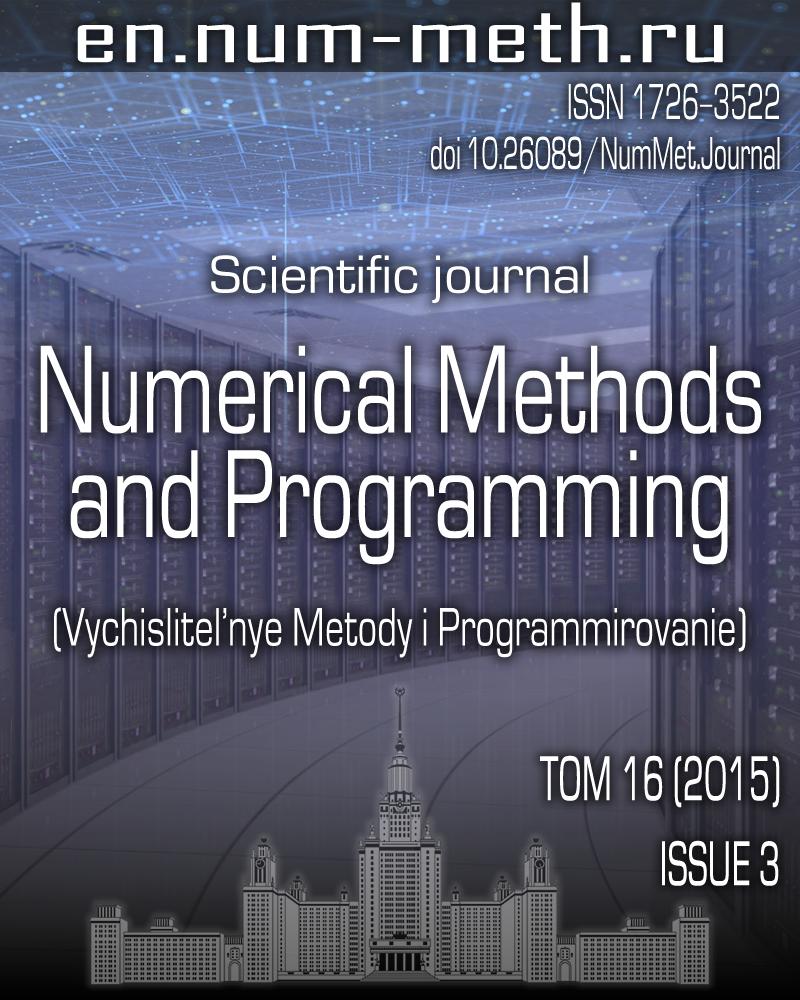DOI: https://doi.org/10.26089/NumMet.v16r340
On the numerical solution of the Neumann boundary value problem for the Helmholtz equation using the method of hypersingular integral equations
Keywords:
Abstract
A numerical method for solving a boundary hypersingular integral equation arising from the Neumann boundary value problem for the Helmholtz equation is proposed. The proposed numerical method is based on the explicit separation of the hypersingular main part in the kernel of the integral equation. After discretization, this boundary integral equation is reduced to a system of linear algebraic equations. The coefficients of this system are represented as the sums of hypersingular and weakly singular integrals. The hypersingular integrals are understood in the sense of the finite Hadamard value and are calculated analytically. A number of quadrature formulas for the weakly singular integrals are developed using the smoothing procedures for singularity. The proposed numerical scheme is tested on the basis of the following model examples: a hypersingular integral equation on a sphere and the problems of diffraction of acoustic waves on inelastic spheres and discs. The numerical solutions obtained are compared with existing analytical and numerical data.
Published
Issue
Section
References
- P. Ya. Ufimtsev, Theory of Edge Diffraction in Electromagnetics (Tech. Science Press, Encino, 2003; Binom, Moscow, 2012).
- G. P. Zouros and J. A. Roumeliotis, “Scattering by an Infinite Dielectric Cylinder Having an Elliptic Metal Core: Asymptotic Solutions,” IEEE Trans. Antennas Propag. 58 (10), 3299-3309 (2010).
- J. G. Meana, J. A. Martinez-Lorenzo, F. Las-Heras, and C. Rappaport, “Wave Scattering by Dielectric and Lossy Materials Using the Modified Equivalent Current Approximation (MECA),” IEEE Trans. Antennas Propag. 58 (11), 3757-3761 (2010).
- Z. Peng, X.-C. Wang, and J.-F. Lee, “Integral Equation Based Domain Decomposition Method for Solving Electromagnetic Wave Scattering from Non-Penetrable Objects,” IEEE Trans. Antennas Propag. 59 (9), 3328-3338 (2011).
- A. L. Bonomo, M. J. Isakson, and N. P. Chotiros, “A Comparison of Finite Element and Analytic Models of Acoustic Scattering from Rough Poroelastic Interfaces,” J. Acoust. Soc. Am. 137 (4), EL235-EL240 (2015).
- P. Rucz, F. Augusztinovicz, J. Angster, et al., “A Finite Element Model of the Tuning Slot of Labial Organ Pipes,” J. Acoust. Soc. Am. 137 (3), 1226-1237 (2015).
- D. A. Konyaev and A. L. Delitsyn, “Finite Element Method with Partial Radiation Conditions for Diffraction Problem on Domains of Complex Structure,” Mat. Model. 28 (8), 48-64 (2014).
- D. Colton and R. Kress, Integral Equation Methods in Scattering Theory (Wiley, New York, 1983; Mir, Moscow, 1987).
- S. M. Rao, D. Wilton, and A. W. Glisson, “Electromagnetic Scattering by Surfaces of Arbitrary Shape,” IEEE Trans. Antennas Propag. 30 (3), 409-418 (1982).
- Yu. G. Smirnov, Mathematical Methods for Electrodynamic Problems (Penza State Univ., Penza, 2009) [in Russian].
- A. I. Mackenzie, S. M. Rao, and M. E. Baginski, “Method of Moments Solution of Electromagnetic Scattering Problems Involving Arbitrarily-Shaped Conducting/Dielectric Bodies Using Triangular Patches and Pulse Basis Functions,” IEEE Trans. Antennas Propag. 58 (2), 488-493 (2010).
- M. S. Tong and W. C. Chew, “Fast Convergence of Fast Multipole Acceleration Using Dual Basis Function in the Method of Moments for Composite Structures,” IEEE Trans. Antennas Propag. 59 (7), 2741-2746 (2011).
- A. G. Polimeridis, J. M. Tamayo, J. M. Rius, and J. R. Mosig, “Fast and Accurate Computation of Hypersingular Integrals in Galerkin Surface Integral Equation Formulations via the Direct Evaluation Method,” IEEE Trans. Antennas Propag. 59 (6), 2329-2340 (2011).
- D. L. Dault, N. V. Nair, J. Li, and B. Shanker, “The Generalized Method of Moments for Electromagnetic Boundary Integral Equations,” IEEE Trans. Antennas Propag. 62 (6), 3174-3188 (2014).
- F. Valdes, F. P. Andriulli, H. Bagci, and E. Michielssen, “Time-Domain Single-Source Integral Equations for Analyzing Scattering from Homogeneous Penetrable Objects,” IEEE Trans. Antennas Propag. 61 (3), 1239-1254 (2013).
- Z. Y. Yan, K. C. Hung, and H. Zheng, “Solving the Hypersingular Boundary Integral Equation in Three-Dimensional Acoustics Using a Regularization Relationship,” J. Acoust. Soc. Am. 113 (5), 2674-2683 (2003).
- W. S. Hwang, “Hypersingular Boundary Integral Equations for Exterior Acoustic Problems,” J. Acoust. Soc. Am. 101 (6), 3336-3342 (1997).
- T. W. Wu and G. C. Wan, “Numerical Modeling of Acoustic Radiation and Scattering from Thin Bodies Using a Cauchy Principal Integral Equation,” J. Acoust. Soc. Am. 92 (5), 2900-2906 (1992).
- Y.-F. Jing, T.-Z. Huang, Y. Duan, et al., “A Novel Integration Method for Weak Singularity Arising in Two-Dimensional Scattering Problems,” IEEE Trans. Antennas Propag. 58 (8), 2725-2731 (2010).
- I. Tsukerman, “A Singularity-Free Boundary Equation Method for Wave Scattering,” IEEE Trans. Antennas Propag. 59 (2), 555-562 (2011).
- I. K. Lifanov, Singular Integral Equations and Discrete Vortices (Yanus, Moscow, 1995; VSP, Utrecht, 1996).
- I. K. Lifanov and S. L. Stavtsev, “Integral Equations and Sound Propagation in a Shallow Sea,” Differ. Uravn. 40 (9), 1256-1270 (2004) [Differ. Equ. 40 (9), 1330-1344 (2004)].
- V. A. Gutnikov, V. Yu. Kiryakin, I. K. Lifanov, et al., “Numerical Solution to a Two-Dimensional Hypersingular Integral Equation and Sound Propagation in Urban Areas,” Zh. Vychisl. Mat. Mat. Fiz. 47 (12), 2088-2100 (2007) [Comput. Math. Math. Phys. 47 (12), 2002-2013 (2007)].
- A. V. Setukha, “The Singular Integral Equation Method in 3-D Boundary Value Problems and Its Applications,” AIP Conf. Proc. 1479 (1), 720-723 (2012).
- S. G. Daeva and A. V. Setukha, “Numerical Simulation of Scattering of Acoustic Waves by Inelastic Bodies Using Hypersingular Boundary Integral Equation,” AIP Conf. Proc. 1648 (2015).
doi 10.1063/1.4912614 - S. G. Lebedeva and A. V. Setukha, “On the Numerical Solution of a Complete Two-Dimensional Hypersingular Integral Equation by the Method of Discrete Singularities,” Differ. Uravn. 49 (2), 223-233 (2013) [Differ. Equ. 49 (2), 224-234 (2013)].
- G. M. Vainikko, I. K. Lifanov, and L. N. Poltavskii, Hypersingular Integral Equations and Their Applications (Yanus, Moscow, 2001; CRC Press, Boca Raton, 2003).
- E. L. Shenderov, Radiation and Scattering of Sound (Sudostroenie, Leningrad, 1989) [in Russian].
- J. J. Faran, “Sound Scattering by Solid Cylinders and Spheres,” J. Acoust. Soc. Am. 23, 405-418 (1951).

